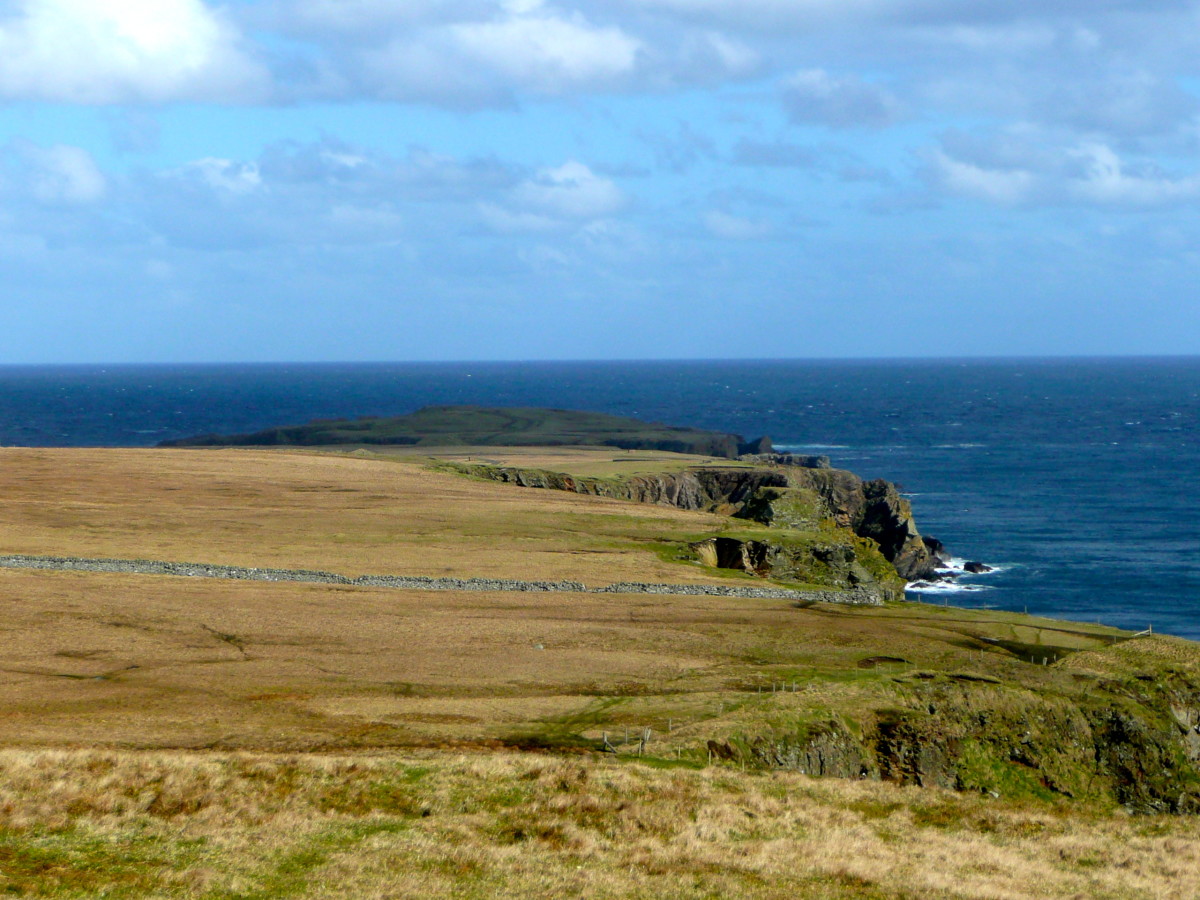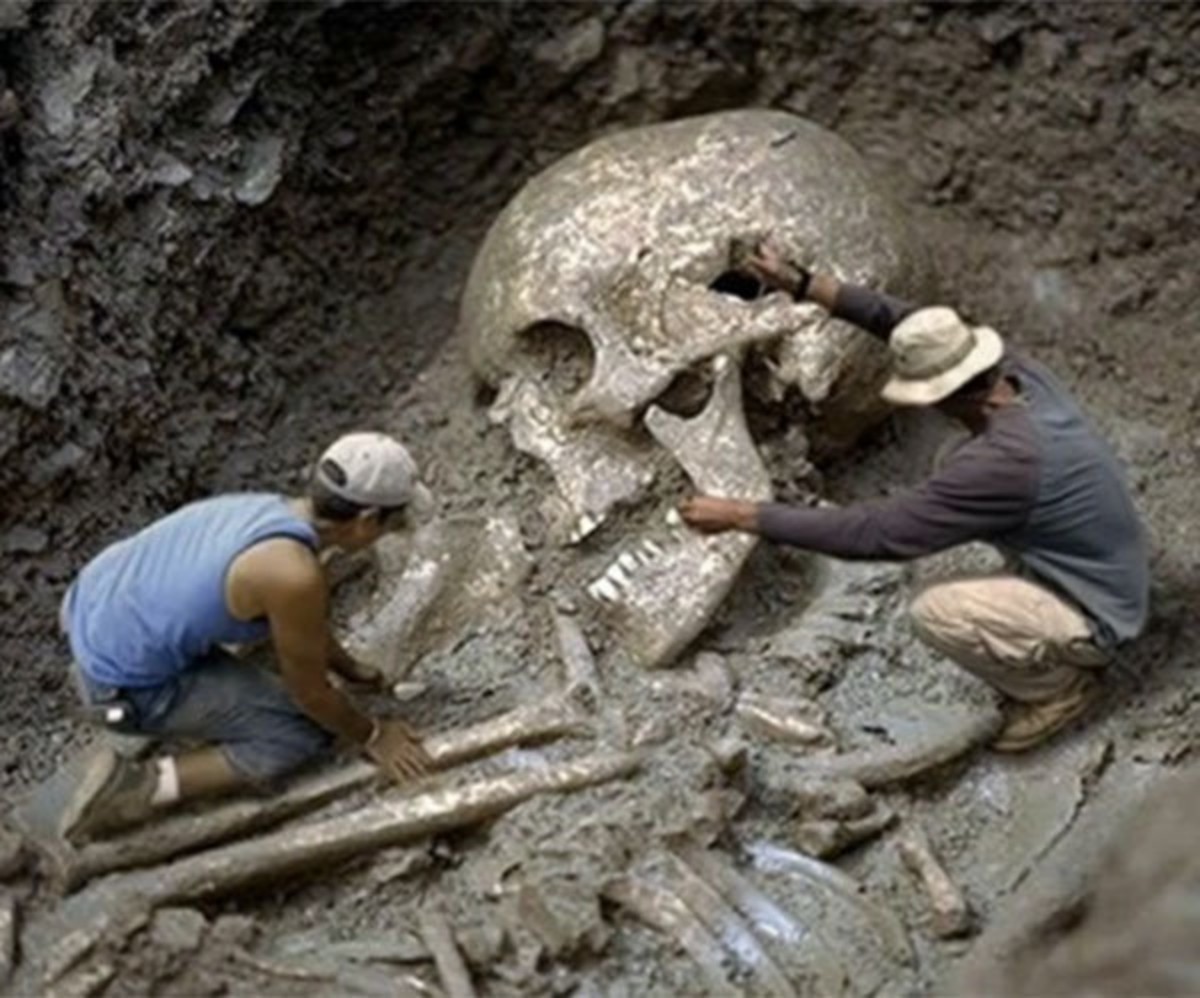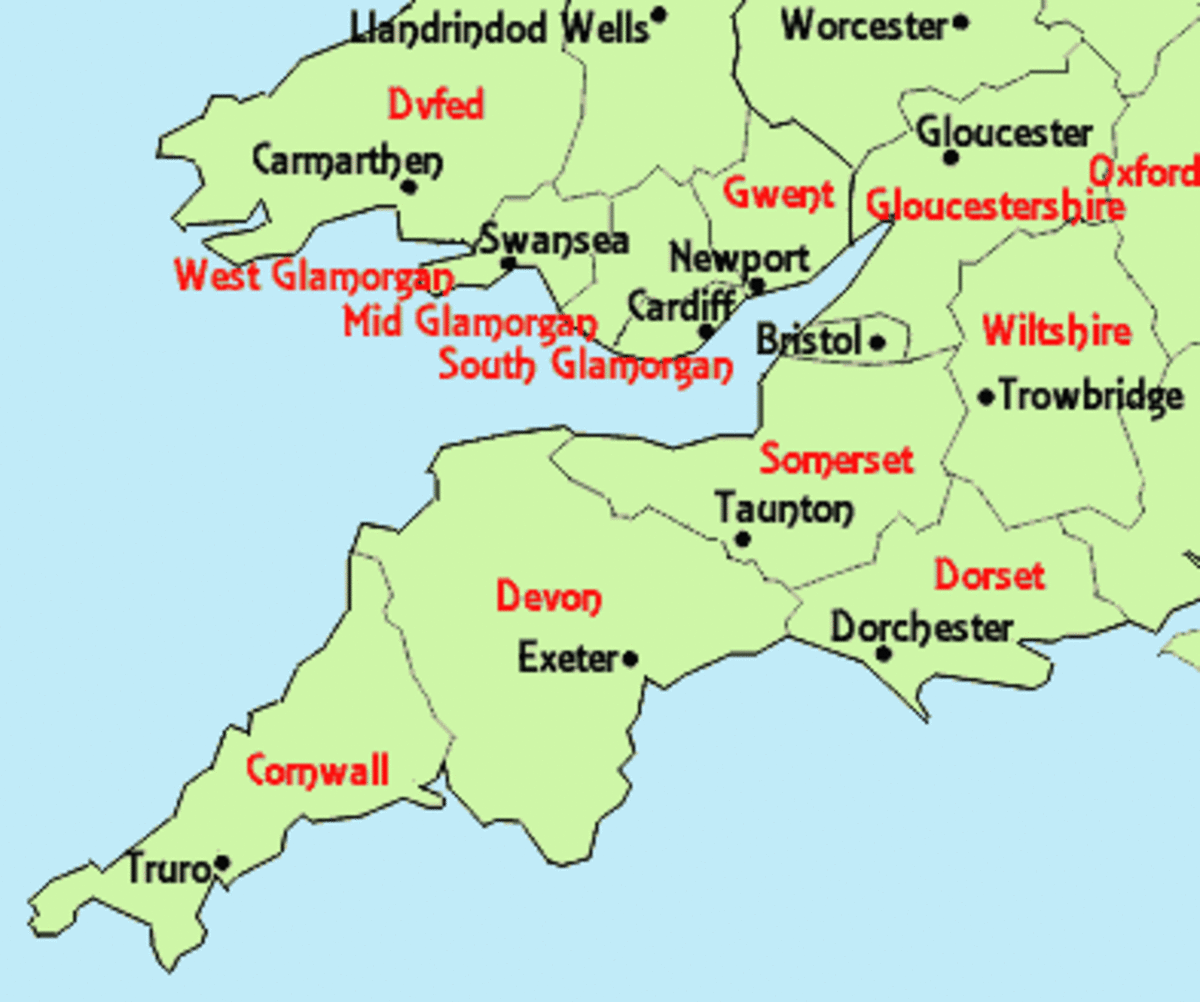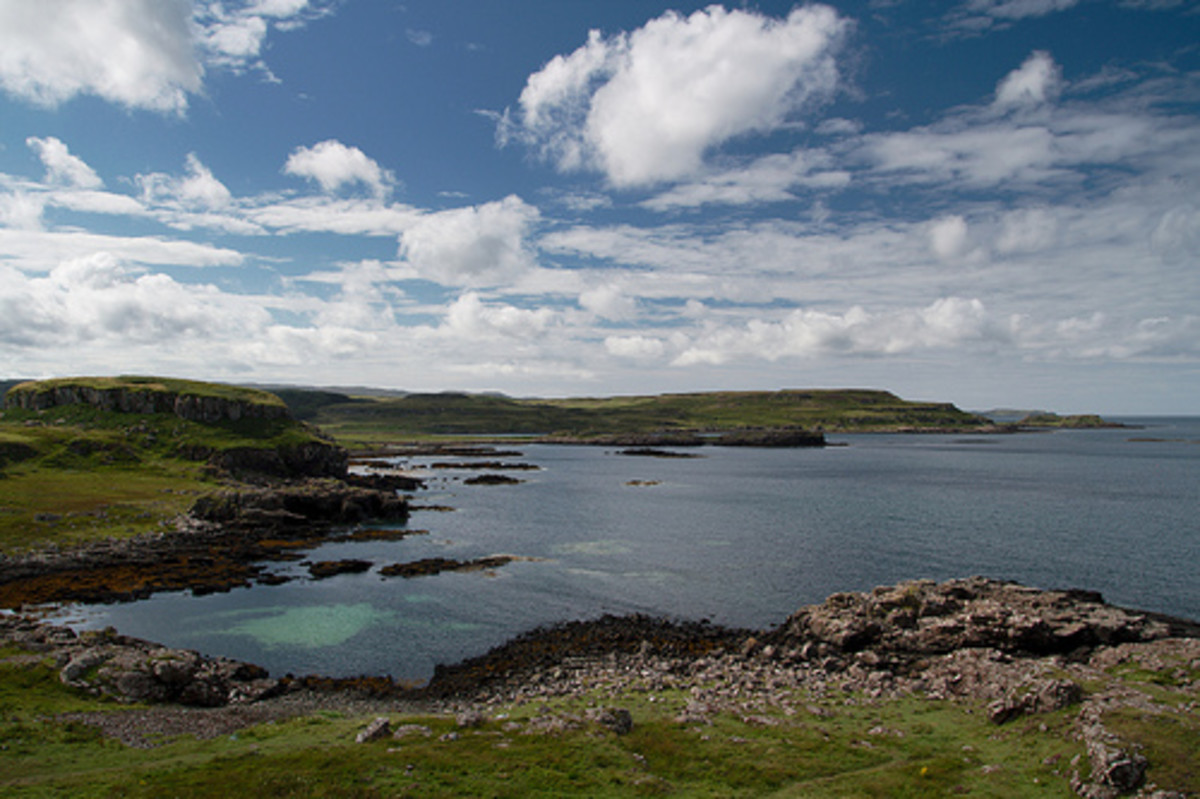- HubPages»
- Travel and Places»
- Visiting Europe»
- United Kingdom
The Udal at North Uist: a Neolithic Wheelhouse and More
How to Find Archeological Digs
In 1981, the Council for British Archeology newsletter gave me the contact information for Iain Crawford’s site at the Udal in North Uist, Outer Hebrides. I was attracted to the Hebrides and Highlands, the shore, the island setting, the sea, the connection with my mother’s family roots in Scotland, the ancient Gaelic culture, and the northern remoteness of the location off the beaten track. I travelled to Scotland for holidays, eager to find some unique places to visit in Scotland.
I arrived by ferry at Lochmaddy from Uig on Skye, my head full of romantic images of bagpipes, swirling kilts, and the revolutionary Flora MacDonald who in 1746 smuggled Prince Charles, disguised as her maid Betty Burke, for whom Flora had procured an exit pass, from Benbecula to Skye after his defeat at the Battle of Culloden, and arranged for his safekeeping and escape to France through her network of underground connections. Even though she was a Presbyterian all her life, in a time when the laws of her country punished or even killed people for practising any religion but the official one, she felt a common humanity and sympathy with the Catholic prince who had been defeated in battle trying to stake his claim to his father’s throne, and rose above the prevailing bigotry and hatred to help him to freedom and safety.
On This Hebrides Island, Traditional Crofter's Cottages Are Still Used
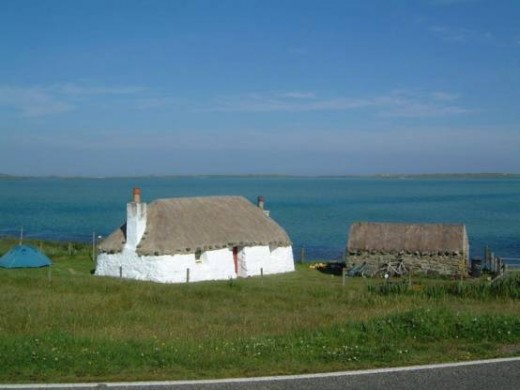
Over the Sea from Skye: from the Highlands of Scotland to the Scottish Isles
With Flora Macdonald in my thoughts, I crossed on the ferry to North Uist singing, “Speed, bonnie boat like a bird on the wing, over the sea to Skye” under my breath. I had been learning Highland dance and Scottish country dance since I was a girl in a small Ontario town, dancing the country dance Flora MacDonald’s Fancy, reading my Gramma Bet’s book about Scottish clans, and looking at the pictures of the Highland tartans. Strictly speaking my Elliott ancestors weren’t a highland clan, but somehow how I was drawn to the rocky terrain that seemed like the Canadian shield rocks and water that had raised me in the Upper Ottawa Valley.
In the summer of 1981 I walked from the ferry landing to the village of Grenitote. A huge green backpack with my down sleeping bag tied below with bungee cords was heavy on my back, but somehow I felt very free. The hills and curves of the narrow, unpainted ashphalt roadway unrolled beneath my hiking boots. It felt like a desolate track to me, with open treeless hills on the left, and on the right fields and rolling dune grasslands which I later learned to call machair, leading to the sea. In the distance were a few white crofts, squatting under roofs of thatch like heavy eyebrows above the two small dark windows in the longest walls. Out of the chimneys a trickle of peat smoke disappeared into the wind. In the damp air and the space, I breathed deeply. Grey clouds misted the hilltops, and the bleak treeless landscape was almost wintry in late June.
Hebrides Scotland
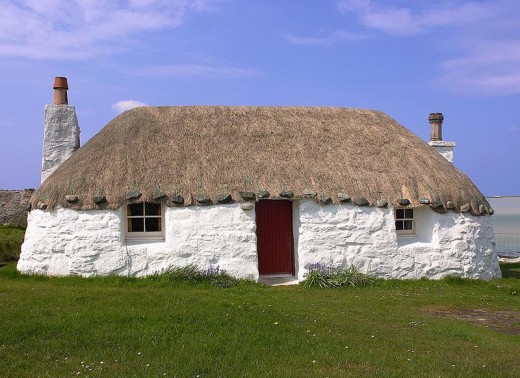
Tea and Bread with Jam
I approached a white sign with GRENITOTE in black letters on it, and scattered beyond it were a few houses. I had no idea where to go from here, or how to find the people I was supposed to meet--Iain Crawford and Mo Robinson. I knocked on one of the doors. A thin elderly woman with grey or white hair answered. She may have been younger than she looked, and she was very kind. Was her name Mrs MacLean? I spoke slowly, not sure if she would understand my Canadian English, or I would understand her Island Scots. I asked if she knew how I could find Iain and the excavation at the Udal. She invited me in for tea and bread with jam. I was starving, having walked for several hours and eaten nothing since breakfast while I was travelling. I was so grateful for her offer of hospitality. I drank tea with her and ate her jammy pieces, and later she took me to the white house nearby where the volunteers were supposed to stay. I had arrived a day early, and was scheduled to start on the excavation the next day. I unrolled my sleeping bag, and fell asleep. Next morning was amazing sunshine, and the hills were golden, green and bright, alive with jewelled colours and sparkle. The sea was blue, bright cobalt, almost tropical, but the temperature was not. I knew I was supposed to wait for Mo and Iain, but I wanted to walk outside. I had not brought a watch, not owning one, in fact, somehow always being able to find a clock in public space when I needed to know the time.
However, today I was late getting back, and Mo and Iain were waiting for me. I felt the blast of Mo’s temper, for they were running a dig, not a tourist camp, and I was holding them up. Mea culpa. We climbed into the Land Rover and moved out to the site, my first journey over the rough track across the machair. Iain gave his tour guide raconteur talk about the site and its history. I liked it when he told stories about the background and the history of the village, and reminisced about his boyhood visits there. I asked questions and encouraged him to talk. He joked with me that I was “from the colonies” and brought a different perspective to the season. I was older than some of the other volunteers, who were mostly still students . I was slightly exotic, from a different country, I was from Canada, I had been working as a Montessori teacher for a few years, I had been living in Canada’s far north in Yellowknife, Northwest Territories, and my perspective was different from those who had lived their whole life in the United Kingdom.
Archeology Digs Volunteers Arrive in The Schoolhouse at Sollas
I was the first of the volunteers to arrive that season. The excavation had already been going for over twenty years when I got there, and the days of huge volunteer crews and massive earth-moving were over. We were scheduled to move in a few days to the schoolhouse in Sollas, as soon as the school year finished and the children went on summer break. At that time, half a dozen volunteers and archeology students would be arriving, as would our camp cook.
The first day I had a site tour, and saw the iron age wheelhouse site where we would be digging, the finds hut called “The Crystal Palace” because it was a clear plastic structure of some kind like a green house, protected from wind and rain, the shuggler where all the dirt would be seived to catch artifacts, and the tea hut. Mo and Iain and their baby son Alasdair were staying in a caravan on the site that summer, and had hired a young woman from Grenitote village to look after Alasdair, who was one and a half or two. He was in diapers, walking and running, and just beginning to talk, and a very active child. No way could he be safe on an archeological site without a babysitter. Margaret was around 16 years old that summer, a rosy-cheeked young woman with light brown hair and a quiet manner.
Archeology Fieldwork in Action
I had some experience on sites before and had learned how to trowel, work neatly, follow sills of coloured sand in the soil, keep a clean workspace without leaving crumbs of dirt and sand; I had learned how to move carefully on the planks and paths to avoid trampling on finds and excavation areas, how to carry bucket after bucket of excavated dirt, how to live with cold and mud and flies and sun, how to work hard and steadily without complaining. I actually loved it. The work is methodical, meditative, calm and active at the same time, and I love being outdoors. I felt so connected with the lives of the people who had lived with those stones, in this wind near this sea, touched by the sun and the rain as I was. Sometimes I imagined voices of the people of those days, laughter around fires, meals whose remains ended in the kitchen midden, mothers carrying two year olds and singing old songs in old languages as they found ways to get their work done even while they supervised the children, keeping the babies out of trouble from the sea, from the animals, from the cold hungry loneliness if they should wander away from the family and fireside.
Gradually the crew grew--Barry came, with a broad accent from North England near Leeds or Manchester. He loved to eat Parkin, which I in my colonial ignorance had never heard of before. Harriet came, a newly graduated speech therapist who loved to ride, and spoke with a plummy accent from the area near London. She was digging for a few weeks vacation before starting her first job, a professional contract in Harris, the next island north. Andrew came, an archeology student from Cambridge, who was a student of Iain’s there. Andrew loved music, had been singing in a boys choir since childhood and liked to listen to the BBC opera and concerts of classical music, singing along to Handel’s Hallelujah Chorus in the breaks. That was before the days of iphones and ipods, and we didn’t work to music, only the sound of the wind, the creak of wheelbarrows, the squeak of wooden bucket handles, the dull scrape of trowels on damp packed sand. Judith came to manage the finds hut. Graham came, tall and thin and quiet. Sara came, a student of archeology at Reading University. Diana came, a daughter of Iain’s friend from near Cambridge, also used to riding horses and wearing green wellies--another oddity for a Canadian, where our rubber boots are black, or black with pink toes. She hadn’t cooked for a group before, but was game to try anything for the summer and looking for something constructive to do in the vacation. She did not enjoy the outdoors or roughing it much, like sleeping on the floor of a school house with no shower. We bathed in the sink and washed our clothes there too. Was there hot water? I cannot even remember, although at that time I surely noticed.
The Royal Wedding, or a Lamb in the Kitchen
That was the summer Prince Charles and Diana Spencer got married on July 29, 1981, and Diana the cook was infatuated with the fairy tale romance of Diana her namesake becoming the princess. Although it all unravelled later, at the time the whole country was rivetted. On the Wednesday of the wedding Iain gave us the day off digging and we were invited to go watch it on the television at a local farmer’s place. We drove over in the Land Rover, and in the farmyard a border collie welcomed us, or not. I have since lived with border collies and learned they are smart, active dogs and not always friendly with strangers, since they are work dogs bred to guard sheep, not welcome strangers, so I am not sure if I only saw the dog at a distance. Maybe the farmer kept her out so she wouldn’t bite us. In the kitchen, the farmer’s black-haired teenage daughter had an orphan lamb, and we got there in time to watch her feed it from a bottle. The mother had had twins, and this one had been pushed out to die, as sheep sometimes do. I had not know that then, not having farm experience. If they can’t raise two, they let the first one suckle, and butt the second one out until it starves or the farmer takes it away to adopt it to another ewe who has lost its babe, or raises it on bottles in the kitchen like this one, who sucked joyfully, wagging its tail as it emptied the bottle in a minute.
In the mornings we rose early and tidied the dormitory where about ten of us slept in sleeping bags on the floor of the larger classroom. There was a sink in the corner near the entrance to the building. There was a connecting door to the adjacent smaller classroom which had a table and chairs and was set up as a dining room. We ate meals there, sat around and talked, and wrote at the tables during free time. That was before the days of internet and computers and cell phones, so in the evenings we mostly sat around and talked, or read, or wrote letters, played games and told stories. Mo and Iain drove up from the caravan at the site every morning to pick up the babysitter from her home in the village and to pick us up. Iain was the head of the excavation, but I had the impression that Mo was the one who got things done. Practical, down-to earth, blunt if she saw sloppy work, but with quick wit and ready laughter that motivated people to do their best.
Trowel Neatly and Walk on the Planks!!
After eating breakfast together, we left Diana the cook to clean up breakfast and we drove off to start digging. We trowelled and filled buckets. We carried our pails of sand up the planks to the outside of the trench, so not to break down the trench face and wreck the profile. We sifted buckets of sand at the shuggler, a rusty mesh on rickety iron legs that we gently shook or “shuggled” to see any small bits of bone, or potshards, or coins or other exciting finds we might have overlooked in our trowelled soil. I didn’t find much. We were not finding many artifacts that summer--we were mostly looking for traces of soil markings and sills that might indicate old patterns of human interaction. For example, old fire pits show black, as do old fence posts, when the organic matter in the ash and wood decompose and color the soil. But I was always hopeful. On other excavations or field walks I had found coins, whole pots, and stones laid in patterns that turned out to be cobblestones on an ancient Roman road near Hadrian’s wall.
It was hard work. Bucket and trowel work, kneeling in the dirt work, working in rain and mud and the endless seaweed flies. The beautiful white sand beach was close and extended for miles, windswept by raw storms from the North Atlantic unbroken by land or islands, for these were the Outer Hebrides, and only water lay between this shore and distant North America. The rough winter storms would tear up seaweed from the offshore kelp beds and deposit it in piles on the long, uninhabited beaches. This was a valuable form of free organic fertilizer, rich in plant growth hormones, trace minerals and phosporous for strong plant roots and abundant flowers, which the people use to enrich the sandy soils of their tilled land. In the spring they load carts on the shore and carry the kelp back to their gardens and fields. In July, the kelp was mostly gone except after heavy winds and storms that deposited it back on the sand after tearing it up in rough seas beyond the bay. Millions of flies lived on it. In the heavy, customary wind that was our constant companion, the flies were blown away, and we had sand in our faces and grit in our teeth. In sunny quiet weather, which came rarely but with joy, the flies crawled everywhere, tickling our faces, sucking liquid at the edges of our eyes and lips, a constant annoyance.
At ten we had a 15 minute tea break. We sought shelter from the wind, huddled together for warmth in the tea hut, cupping our stiff hands around warm cups and munching crispy biscuits, usually chocolate coated Digestives that we had packed with us from the school house in the morning. We had a break, had some conversation, laughed, rested, and then went back to our work.
At noon we had a lunch break and ate a packed lunch Diana had sent. We had an hour, to walk around, stretch our legs and ease our backs, go look at the morning’s finds in the Crystal palace, talk to each other. I liked to walk to the shore, to look across the bay to the islands that had been inhabited decades ago by isolated families whom the local government had taken off at some point and relocated on the main island. Their old crofts were still there, now unwhitewashed, the rotting thatch unrepaired, and the stone walls falling. A couple of brave souls would go swimming on sunny days, but I was never warm enough to swim. The English and Scots must be hardier than the Canadians in that respect, but even in long underwear under my jeans I was almost always cold. I never saw the locals swimming in the sea, either, now that I think of it. Despite the vibrant tropical colours of white sand, green marram grass and turquoise water on a sunny day, the water was cold, and the wind was chill.
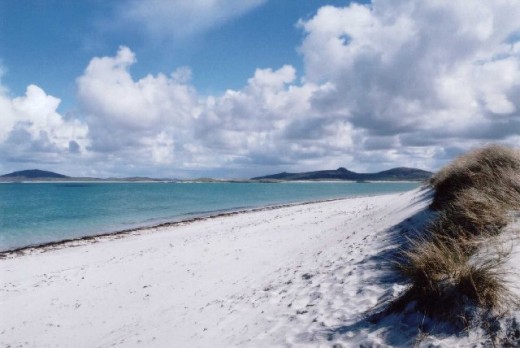
Machair, Peat Bogs and Cider
We had a day off every Saturday afternoon and Sunday. I would walk around on the machair, or along the road to see the land. There were only two directions to go along the road--northeast toward the main town of Lochmaddy and the ferry terminal, where I had come in, and south toward the airport at Benbecula, past the small grocery store and post office that stocked one of practically any item you might need, but you had to ask for it from the postmistress, for they weren’t displayed in self-serve style as I was used to from North America. I found it embarrassing to ask for some essentials, like sanitary napkins or tampons.
Past the grocery store and going toward Malaclate in the direction of the farm where we had watched the Royal Wedding on TV there was a bright red telephone box. Nobody had cell phones then. They weren’t yet invented. If we wanted to make a phone call, we had to walk to the call box, talk to the operator and make a reservation to place an overseas call so we would be sure to get a line. The call box was bright red with rounded edges--I recognized them later when I saw English films like What a Girl Wants and Harry Potter, with the famous entrance to the Ministry of Magic.
Once I had walked the road in both directions, I would usually head across the machair and walk without a track, breathing the wind, the fragrance of the tiny bright flowers, daisies, arctic cotton, sedges and grasses. I watched millions of rabbits, some of them with the blind swollen eyes of the viral rabbit disease myxomatosis.
Rabbit with Myxomatosis
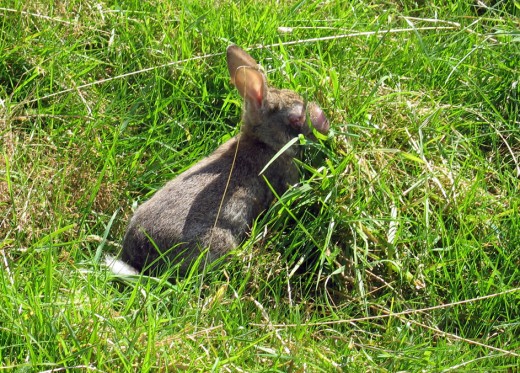
I would practice Tai Chi on the machair flowers in the wind. I once walked up into the hills, skirting peat bogs and passing the odd sheep grazing near dipping stations, where they would rub against the fence to scratch and leave chunks of fleece caught in cracks and splinters of the weathered grey wood. From high rocky outcrops I looked down across the land, past the village, to the sea and white beach. The bleat of sheep on the pastures, the smell of peat fires, the blue, green, mauve, grey, and silver colors of distant rocks, the slate gray sea, and the bright flowers and shrubs blended into the warp and weft of Harris tweed. Iain drove us one day to the kipper smoker, to a man who wove tweed on an old hand loom in his back shed, a dying art I think, dyeing the yarn and fixing the colour in sheep urine in the traditional way, then weaving the old patterns in the colours of the land. At that time I was learning to spin and dye yarns using natural plant dyes of the northwest territories, soaking the spun yarn in decoctions made from the lichens, grasses, willows and berries of the barren rocky land and taiga where I lived. I was interested in talking to this old man who had been weaving and dyeing his whole life, using the plant dyes from the northern landscape of his island tradition.
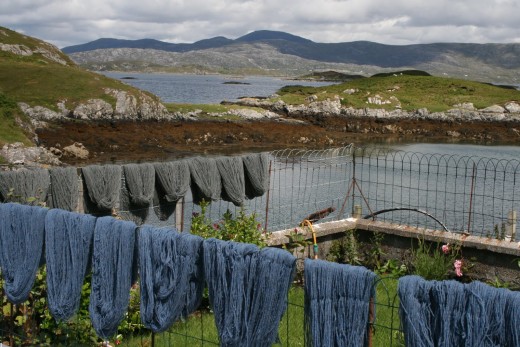
The weaver also smoked herring and sold kippers to his friends, of whom Iain was one. In those days Iain was a colourful character, a story teller, personable, with a certain charm, who had been coming to the village since childhood and could speak some of the Gaelic. His hair was sand-coloured and grizzled with grey, long and windblown and always unkempt. He wore a green tweed jacket with leather patches on the elbows, his cheerful face above it roughly shaven and tanned. He always looked slightly wild and was becoming portly with his professor’s sedentary life. A man with fascinating stories, and he told us about the village and introduced us to people around whom he thought would interest us, or whom our visitor’s tourist dollars might help. I liked him.
Sometimes we stopped in at the pub in Carinish on Sunday afternoon--an odd idea for a Canadian from puritanical Ontario, where pubs at that time were not open on Sundays, where even liquor stores were not, and beverage service was only allowed with meals after noon. We sat one rainy Sunday afternoon in the Carinish Inn pub and drank toasts to each other in glasses of cider or pints of dark Guinness to savour the local flavour, which I did not really like. Some of us played darts and joked and talked with the village people, mostly middle-aged and elderly men, who were there.
Beached Seal Pup
One morning when we drove the Land Rover along the beach track, we found a seal pup on the shore. Our regular path across the machair was too soggy after several days of heavy rain. The Land Rover might get mired, and its wheels would damage the delicate ground cover of the machair, so on days like that Iain would take the longer way around the beach, using the farm tracks. This meant many gates, so at each one the front seat passenger would hop out, open the gate, wait while we drove through, then close the gate behind us and run back to the Land Rover. As we approached the beach we saw a flock of gulls alighting and flying, clearly gathering around some kind of prey on the beach. Iain recognized it first, a small furry body of a baby seal. The mother had left it there to wait for her while she went out to sea to hunt and eat, and the baby seal had exhausted itself flippering its way up the beach, trying to escape the gulls that ran at it on the sand, or swooped and pecked it from above. The tide was very low and the water was far away. Moreover, the seal pup had confused its direction, for it kept pulling itself further and further toward the grass, and away from the water.
“We need to get a milk box and carry that seal pup to the water,” Iain told us. “The gulls will peck its eyes and blind it, then kill it.” I looked at him with horror.
We didn’t have the milk box with us, so Iain said the Land Rover would go back and get one, and one of us needed to stay with the seal and scare off the gulls until he got back. I wanted to. I hopped out of the Land Rover and approached the pup. I had never seen a seal up close before. Its body was furry, its soft brown eyes limpid with consciousness and fear as I came in view. The gulls scattered as I walked up, not too close but enough to assert my presence. The baby seal put its head on the sand and panted. We waited together. I learned later that the mothers do this. Many years later when I lived in Burnaby, British Columbia, I took my two-year-old daughter to Crescent Beach south of Vancouver, and we found another baby seal there, resting at evening waiting for its mother to return from the fishing expedition at sea. Here there were no screaming gulls, and the seal pup was resting peacefully, waiting where it had been left, trusting its mother would come soon. I remembered the seal pup at Grenitote, and I wondered if its mother had come back soon.
After some time the Land rover drove up with the milk crate and we tipped the seal pup into the crate without touching it, so not to leave our scent on the baby and trigger the mother’s possible abandonment if her baby smelled foreign. We carried the seal pup half a mile or more across the shallow tidal pools and sand flats, to where the water began. We tipped it in and watched it swim away. I always wondered what came of the seal pup. Would it stay near the place its mother had left it so she would know where to find it again? did we really help it, or not?
Gray Seal Pup, Mull
Harbour Seal Pup, California
Leaving the Isles
In August the days were getting shorter and colder, and it was no longer light most of the night. Before the season ended I was scheduled to leave. I left the schoolhouse at Sollas in the post van to Benbecula taking the the mailbag to the airport. From there, I hitched a ride to Harris, and stayed for a day or two with Harriet, one of the volunteers who had left before I did to start her work as a speech therapist in Leverburgh, Harris. It was her first job, and she did not yet have friends in town. She had a house that came with the job, and she was as glad to have some company as I was to have an adventure. We had fun for a couple of days, and then I caught the ferry from Leverburgh to Ullapool on the mainland. There I camped in the hills for a few days, walking above Ullapool and Achiltibuie until it was time to finish my summer in Scotland with a few days in Edinburgh before heading for the airport at Glasgow for my home flight to Toronto. I had wanted to make it to Findhorn near Aberdeen, but had not been able to pull myself away from the Hebrides, and left Findhorn and the other side of the Highlands for another trip.
Since that wonderful summer I have thought a million times of the island, the people, the site at the Udal, the compelling story of how the site was opened by a freak spring tide, exposing a gravesite. Local people from the village reported the skeleton to the police, who investigated and realized this was not a crime scene, but an archeological find. It turned out to be one of the most significant sites in northwest Scotland, a site continually inhabited from neolithic times until the early 20th century, when locals would work there to gather kelp. Many times since then I have travelled to places with constant wind: I have perched on rocky cliffs in Thailand’s Koh Phangan island, sat on the prow of a sailboat in the Bahamas, slept in open concept resort rooms with no fourth wall at Anse Chastanet in Saint Lucia, walked the boardwalk along Burrard Inlet at Rocky Point Park in Port Moody, British Columbia, chanted mantras into the wind on the yoga palapa at Ceiba del Mar in Mexico. Invariably, when I am in the company of the wind, singing and sighing and filling me with energy and spirit, I feel in touch again with the fragrant wind of the machair and the white sand beaches and high dunes of North Uist shore near the Udal.
In January, 2010, I was surfing the web and started looking for information about North Uist, the dig at the Udal, and Iain Crawford and Mo Robinson. I had had some luck in using Google to get back in touch with people from previous periods of my life, and had been enjoying the experience of reconnecting with friends from childhood or university. I found little, only a blogpost by UistLady that let me understand the excavation had concluded, but the research report was unwritten. I wondered what had happened to Iain, to Mo, to Alasdair, to the site and the village. Then out of the blue I got an email one day from Judith Aird, who had been the finds assistant in the summer I was there. Somehow in her search for previous visitors and volunteer excavators she had found me on the web through my Hubpages site at janisgoad.hubpages.com. She put me up to date with Beverly Ballin Smith’s appointment as Lead Researcher to manage the grant, get the website up and running and complete the research report so the finds could be catalogued, displayed, and returned to the village. Potentially they could catalyze the development there of a tourist point of interest that would bring the heritage home to the village and allow them to develop a stream of income from archeological tourism. I would love to be one of the first tourists back to support such a project.
For Mo Washing Diapers in the Sea
I search through old photographs, but don’t find any of the site when I was there. I look for old journals I may have written then, but I think I threw them out when I was trying to empty my life and preparing to move from my home of twenty years to a new town to start a new job in Kamloops. I find only one sheet, a poem from August 1981. The layers of palimpsest have faded. They vanish. Nothing remains but my memories, and the yearning to come back to the island and breathe the wind.
For Mo Washing Diapers in the Sea
Woman, I watch you fade in mist at
sea’s edge. You wring an ancient,
endless ritual. You rub small garments
in surf-grey sand. You beat a child’s
shirts on tide-worn rock, your bare
calves plinths in foam that collars
the cove in the headland’s lee.
After, you crouch beside me in this
circle of stone. A cold damp hearth
now crumbles, where tumbled walls
encompass pitted floor, shattered lintel,
shards of old desire. While neolithic
laughter layers us, drizzle shrouds
our chore in silence, our breath in
puffs of dreams suspended.
Trowels ring on stone, clean
strokes in clinging sand
brush bright bone, the secret
shawl of earth drawn back
reveals a cold and ancient dwelling.
Now, neolithic woman, in your brief
derelict home we kneel. Storm-clad
in mist and spray, sea-bound
at edge of land, did you so toil
in your time to teach the child you
loved?


